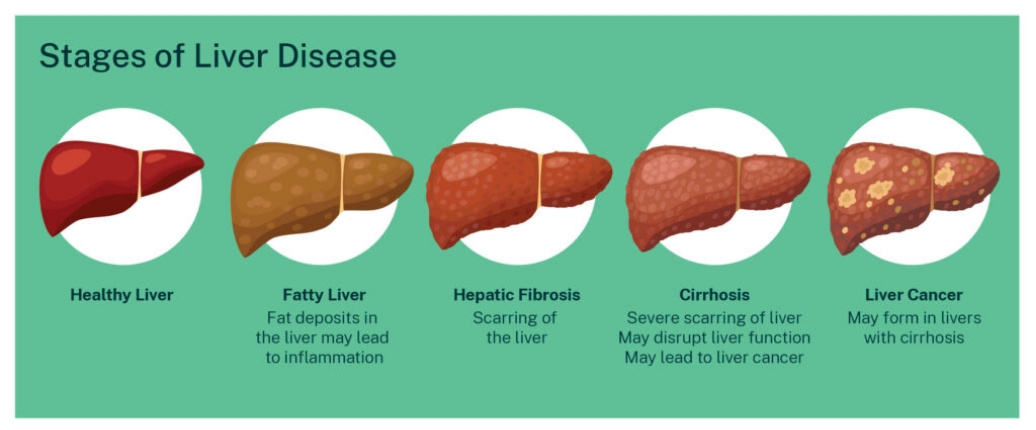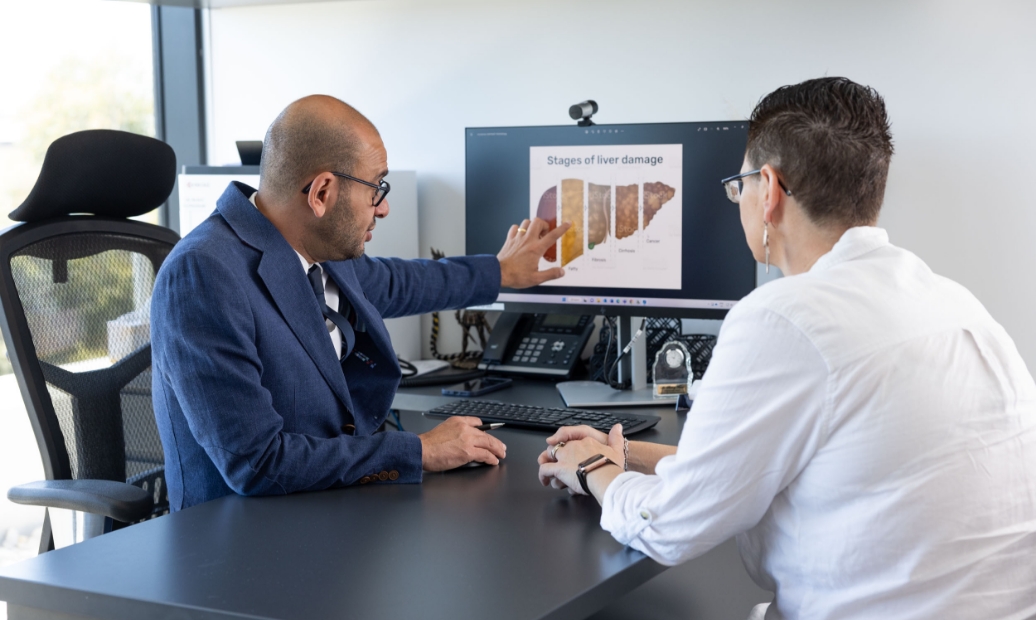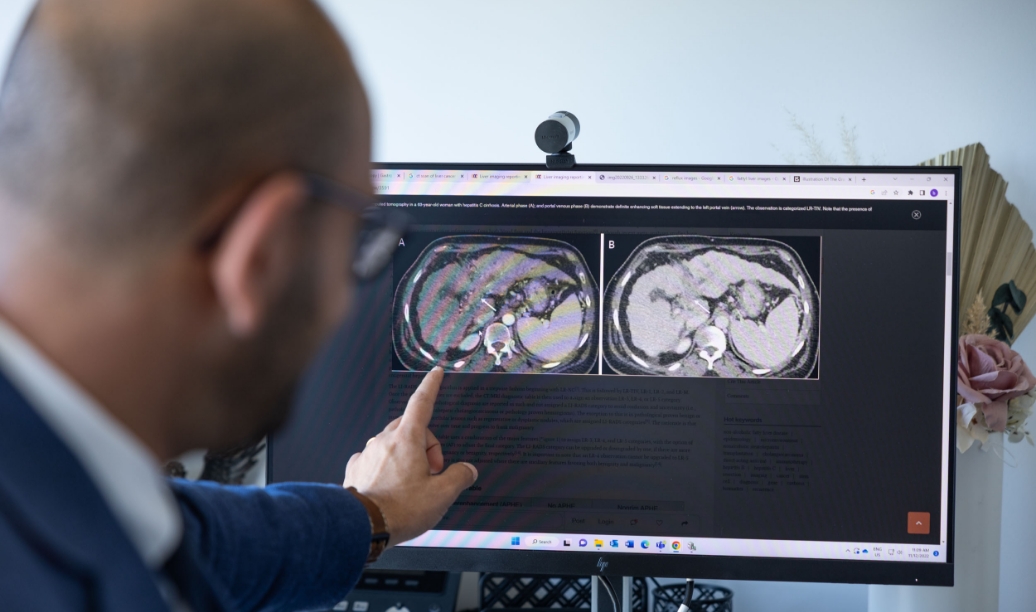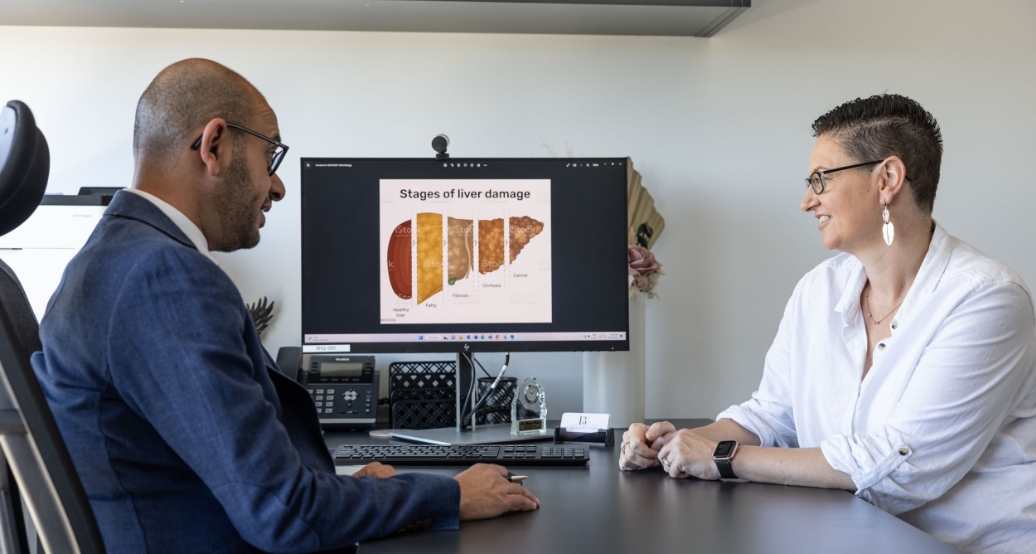Liver Disease Management
Cirrhosis Overview

Cirrhosis is a disease in which the liver becomes severely scarred, usually as a result of many years of continuous injury. The most common causes of cirrhosis include heavy alcohol use, fatty liver disease (often seen in people with obesity or diabetes), and chronic hepatitis B or C (viral infections that affect the liver).
In its advanced stages, cirrhosis is usually irreversible, so treatment may involve liver transplant. In its earlier stages, cirrhosis may be reversible if the underlying cause can be treated.
Cirrhosis Causes
The liver is a large organ (weighing about three pounds) that is located in the right upper abdomen beneath the rib cage. It performs many functions that are essential to life.
The liver is able to repair itself when it has been injured. However, the process of healing involves the creation of scar tissue. Thus, repeated or continuous injury to the liver (such as occurs with heavy alcohol use) can cause significant scarring in the liver.
The body is able to tolerate a partially scarred liver without serious consequences. Eventually, the scarring can become so severe that the liver is no longer able to perform its normal functions.
There are many forms of liver disease that can lead to cirrhosis. In the United States, the two most common causes of cirrhosis are alcohol-related liver disease and hepatitis C, which together account for roughly one-half of the people awaiting a liver transplant.
In resource-rich countries, common causes of cirrhosis include the following, but many other causes also exist:
- Longstanding heavy alcohol use
- Nonalcoholic steatohepatitis
- Chronic hepatitis (B or C)
- Hemochromatosis (a condition that causes iron to build up in the liver)



Call us today for an appointment at Gledswood Hills or Shellharbour
Cirrhosis Signs and Symptoms
People with cirrhosis sometimes have no symptoms, but the condition can cause a long list of possible signs and symptoms, not all of which occur together. Some of the more common symptoms include:
- Loss of appetite
- Weight loss
- Weakness
- Jaundice (yellowing of the skin or eyes)
- Itching
- Signs of upper gastrointestinal bleeding (such as vomiting blood, or having bowel movements that look like tar or that contain blood)
- Swelling in the abdomen (caused by a condition called ascites, in which fluid builds up around the organs in the abdomen)
- Mood changes, confusion, or abnormal sleep patterns (caused by a condition called hepatic encephalopathy)
- Muscle cramps, which can be severe
- Absent or irregular menstrual bleeding
- Erectile dysfunction, infertility, or loss of sex drive (in males)
- Breast development in males
- Spider veins


Portal hypertension
Cirrhosis can cause a problem called portal hypertension, which is when the blood pressure inside the portal vein, the main source of blood for the liver, gets too high. This happens because scars in the liver obstruct blood flow through the organ.
As the pressure builds up, blood backs up into nearby blood vessels, primarily in and around the esophagus and intestines.
Changes in the hands
Cirrhosis can affect the hands, causing the palms to redden, the nails to whiten or develop white stripes, and the tips of the fingers to widen. It can also cause a condition called Dupuytren’s contracture, in which tissues in the hand shrink and harden, ultimately limiting the mobility of certain fingers.
Blood abnormalities
People with cirrhosis often have a number of abnormalities in their blood. For example, they can have abnormal levels of certain proteins and enzymes, and their blood may not clot as well as it should. Plus, they do not always have enough of certain blood cells.
Cirrhosis Diagnosis

If cirrhosis is suspected, an ultrasound of the abdomen will usually be done. A liver biopsy may also be requested, it involves using a needle to get a sample of liver tissue so it can be examined for signs of damage. A biopsy may not be necessary if the symptoms, blood tests, and imaging tests all point to cirrhosis.
An alternative method for diagnosing cirrhosis is a test called FibroScan, which uses ultrasound to measure liver stiffness. This measurement can then be used to estimate how much scarring there is in the liver and to determine if cirrhosis has developed.
Cirrhosis Treatment
When treating people with cirrhosis, there are a few major goals to be achieved. Dr Farah will discuss each of them during the consultation:
- Slow or reverse the cause of the liver disease
- Prevent, identify, and treat the complications of cirrhosis
- Protect the liver from other sources of damage
- Manage symptoms and blood abnormalities
- Determine if and when a liver transplant is needed
The first part of treatment for cirrhosis involves identifying its underlying cause and treating that, if possible. For example, if a person’s cirrhosis is due to heavy alcohol use, it’s imperative to get the alcohol use treated and under control. Likewise, if a person’s cirrhosis is caused by an infection, such as hepatitis C, it’s important to treat the infection.

Complications of Cirrhosis

When it is healthy, the liver has many jobs, among them to filter toxins out of the blood, break down certain drugs and alcohol, and make proteins that are important in clotting or digestion. Cirrhosis can lead to many complications, some of which happen because the liver is no longer able to do these jobs well, and some of which happen because blood flow through the liver is disrupted.
The major complications of cirrhosis are described below.
Esophageal varices are dilated blood vessels in the esophagus. These blood vessels swell because the blood flow through the liver is blocked by all the scarring, causing blood to back up into the veins in the esophagus and stomach. When the pressure gets too high inside these blood vessels, they can burst and cause severe bleeding (also called variceal hemorrhage).
The main symptoms of variceal hemorrhage are vomiting blood or having bowel movements that contain blood or that look like tar (which indicates the presence of blood in the stool).
For reasons that are not entirely understood, people with cirrhosis sometimes accumulate fluid in the abdomen. This condition, called ascites, causes the abdomen to swell. Ascites can also cause a person to feel short of breath or full. To treat ascites, diuretics are prescribed to help the body excrete excess fluid. It is also recommended that people with the condition reduce the amount of sodium they consume.
In extreme cases, the specialist will drain fluid from the abdomen using a technique called paracentesis.
People with ascites sometimes develop an infection of the fluid, known as spontaneous bacterial peritonitis. These infections do not always cause symptoms, but when they do, symptoms can include fever, abdominal pain or tenderness, and confusion or grogginess.
The specialist diagnoses these infections by draining some of the fluid in the abdomen with a needle and checking it for bacterial growth and white blood cells (which are involved in fighting infection). Treatment involves strong antibiotics and diuretics to reduce fluid buildup in the abdomen. People with these infections sometimes also have to stop taking medications called proton pump inhibitors, which are used to treat acid reflux.
These medications stop the production of stomach acid. Since stomach acid is one of the ways the body protects itself from bacteria, people with ascites who take these medications are at increased risk of infection.
For reasons that are not entirely clear, cirrhosis can adversely affect brain function. One explanation is that toxins build up in the blood when the liver is malfunctioning, possibly interfering with normal brain processes. Hepatic encephalopathy is the medical term for the disruption in brain function caused by liver disease. It can manifest as sleep disturbances (sleeping too much, too little, or sleeping during the day); mood or personality changes; trouble concentrating or thinking clearly; shaking; or slurred speech.
Hepatic encephalopathy can sometimes be treated and normal brain function restored. Treatment involves getting other stressors, such as infections and bleeding under control, or taking certain medicines, such as Lactulose (which will cause softening of the stool) or an antibiotic called Rifaximin.
Hepatorenal syndrome is a form of kidney disease that results from cirrhosis. It happens in part because the interrupted blood flow through the liver restricts blood flow to the kidneys.
Hepatorenal syndrome does not necessarily cause symptoms, though it can cause some people to urinate less than usual. The condition is detected with blood and urine tests. Hepatorenal syndrome is treated by trying to improve liver function (for example, stopping alcohol or treating hepatitis B). If the liver function cannot be improved, liver transplantation is often needed.
Cirrhosis and the related problems it causes with circulation can lead to a number of problems with the lungs and heart. When these organs are affected, people can have fatigue, trouble breathing, chest pain, and other symptoms.
People with cirrhosis have an increased risk of developing liver cancer, especially if their cirrhosis was caused by hepatitis B, hepatitis C, nonalcoholic steatohepatitis, or hemochromatosis. Given this elevated risk, people with cirrhosis should have an ultrasound every six months to check for signs of cancer.
When liver cancer first develops, it often causes no symptoms of its own. As it progresses, it can either exacerbate the complications of cirrhosis or cause symptoms such as pain, feeling full quickly, and jaundice. Some people with liver cancer from cirrhosis are treated with a liver transplant, which removes the cancer. People who may be candidates for a liver transplant include those with small cancers that have not spread outside of the liver.
Prevent Further Damage to the Liver
People with cirrhosis have to be extra careful about protecting their liver from anything besides their liver disease that could harm their liver. Steps to protect the liver from further damage are described below.
Vaccines against hepatitis A and B for those who are not already immune can help prevent further damage to the liver. Because infections can be especially hard on people with cirrhosis, it’s also important to get other vaccines, including vaccines to protect against the flu (once a year), pneumonia (at least once), diphtheria and tetanus (once every 10 years), and pertussis (once during adulthood).
People with cirrhosis should avoid all substances that are known to damage the liver. This includes:
- Alcohol
- Nonsteroidal antiinflammatory drugs, such as Ibuprofen
- Some supplements and herbal remedies, such as kava kava
- Some prescribed medications
Also, people with cirrhosis who take Paracetamol should not take more than 2,000 milligrams per day (four extra-strength tablets). Many over-the-counter and prescription medications to treat cold and flu, fever, pain, and other common maladies contain acetaminophen, so it’s important to check the labels of any medications for acetaminophen as an ingredient and to add up the milligrams they each contain.
Aside from needing to avoid certain medications and substances, people with cirrhosis sometimes need to take less of certain medications than people with healthy livers. That’s because one of the jobs of the liver is to break down medications and clear them out of the blood. When the liver is not working well, those medications can build up in the body and become toxic.
Separately, some medications can have side effects that worsen the complications of cirrhosis. Medications called benzodiazepines for example, which are used to ease anxiety, can worsen hepatic encephalopathy.
To find out if anything you take could harm your liver, put all the bottles of all the medications you take into a bag and take them with you to the doctor who manages your liver disease. Include all over-the-counter medications, supplements, and herbal drugs, as well as any prescriptions you take. Never start any new medications or supplements without first checking with your doctor. Also, any time you are being prescribed a new medication, make sure the healthcare provider prescribing it knows about your liver disease.
Manage Sumptoms and Blood Abnormalities
People with cirrhosis sometimes develop symptoms related to their disease that are distinct from the complications discussed above. They also sometimes have blood abnormalities that require treatment.
People with cirrhosis sometimes get muscle cramps, which can be severe. There are few treatments for cramps.
An umbilical hernia is a swelling or bulge that forms at the belly button . This type of hernia happens when the tough layer of tissue that normally contains the abdominal organs—called the abdominal wall—becomes weak. As the abdominal wall gives way, the contents of the abdomen start to push through, creating a bulge. Sometimes doctors can gently ease the tissues that bulge through the hernia back into the abdomen (this is called reducing the hernia). But if the tissue that bulges out through the hernia gets squeezed too tightly, it can get cut off from its blood supply and begin to die (this is called incarceration).
Umbilical hernias can be repaired with surgery, but people with cirrhosis can often have serious complications with surgery, and the surgery does not always fix the problem. As a result, doctors are often hesitant to recommend surgery unless there is a serious incarceration. Except when it is urgently needed, doctors often suggest waiting and doing hernia repair at the same time as a liver transplant.
Hyponatremia is the medical term for “too little sodium in the blood.” People with advanced cirrhosis commonly develop hyponatremia, and it can be serious.
Sodium is one of many substances called electrolytes that help carry electrical signals between cells. That’s important because many cells rely on electrical signals to function normally. Sodium also helps keep the right amount of fluid inside cells. Maintaining the right concentration of sodium in the body is important. Unfortunately, restoring normal sodium levels in people with cirrhosis and hyponatremia is difficult to do. Often hyponatremia heralds the need for a liver transplant.
The blood of people with cirrhosis often does not clot as it should. That’s because the liver is responsible for making many of the proteins and other substances that orchestrate the formation of clots. This is a problem, because it puts people with cirrhosis at risk of serious bleeding, particularly if they also have esophageal varices Because treating the problem involves a type of blood transfusion, doctors usually only do so if the person is about to undergo a surgery or procedure that could cause bleeding.
Some people have problems with too much clotting, which can lead to clots forming where they are not needed. A common place for this to occur is in the large vein that leads to the liver (called the portal vein). Clots in the portal vein can make portal hypertension worse and may lead to the development of new varices in the esophagus or stomach.
Liver Trasplant for Cirrhosis
Liver transplant involves replacing a diseased liver with a healthy liver. It is the definitive treatment for people with advanced cirrhosis. Still, not everyone with advanced cirrhosis is a good candidate for a transplant. Some of the reasons why people might not be good candidates include liver cancer that has spread outside the liver, or significant heart or lung disease. Liver transplant is a complicated, major surgery, so people undergoing the surgery need to be healthy enough to survive the surgery and recovery. What’s more, even people who are good candidates must wait for a compatible liver to be available.
The waiting list for a liver transplant is lengthy (up to two years in some regions), so it is important for people to find out as early as possible (while they are still relatively healthy) if a liver transplant is a reasonable option. The majority of donated livers come from people who have suffered brain death for one reason or another. More recently, living donors have been able to donate a portion of their liver.
More than 80 percent of people will be alive one year after a liver transplant, and the majority of these will be alive five years after the transplant. This is compared with an extremely high death rate in patients with very advanced cirrhosis who do not receive a liver transplant.
The prognosis after a liver transplant depends in part on the underlying cause of the liver disease, some of which recur following the transplant. For example, most people who undergo a transplant for hepatitis C will develop recurrent hepatitis C after the transplant.
Other major concerns following a transplant are the risks of anti-rejection drugs used to suppress the immune system, which have many side effects, and the risk of rejection of the transplanted organ.